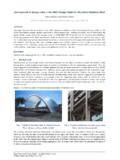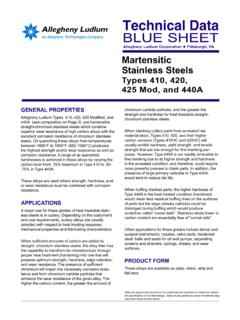Transcription of Corrosion Resistance and Biocompatibility of Passivated ...
1 25 March 2009 NDC Business System R2 Letterhead (scale 80%) Option #147533 Westinghouse Drive Fremont, California 94539 t f are Nitinol. Corrosion Resistance and Biocompatibility of Passivated Nitinol Trepanier, Venugopalan, Pelton Shape Memory Implants (ed.) L H. Yahia pp. 35 45 2000 Corrosion Resistance and Biocompatibility of Passivated NiTi Christine Trepanier, Ramakrishna Venugopalan, Alan R. Pelton 1 Introduction Equiatomic nickel-titanium (NiTi) or Nitinol possess a unique combination of properties, including superelasticity and shape memory, which are very attractive for biomedical applications. NiTi has been used in orthopedic and orthodontic implants for several decades and has contributed to significant improvements in these fields [1,21. This alloy is rapidly becoming the material of choice for self-expanding ste nts, graft support systems, filters, baskets and various other devices for minimally invasive interventional procedures (Fig.)]
2 I) [1,31. While the s uperior performance of NiTi over conventional engineering materials for implants is well document ed [1,4, 5 J, the high nickel content of the alloy (55 weight % Ni) and its b , Flg. l . Yariolls lypes of minimally invasive inlervenlional NiTi devices. a Cordis SMART sten\. b Simon filler. c Mitek bone anchor 36 Ch. Trepanier el al . possible influence on Biocompatibility continues to be an issue of conce rn. This concern is further complicated by the cOIlOicting literature on cor rosion resi stance. Human tissue contains approximately ppm of nickel, which is essential in nutrition for biological functionality of the human body (6,71. The potential for higher nickel concentration release from implant material may generate harmful allergic, toxic or carcinogenic reactions 17-91. Besides NiTi and 316L stainless steel, anothe r high nickel containing alloy, MP3SN (35 weight % Ni), exhibi ts good Biocompatibility and is used for implants in orthodontics, orthopedics and car-diovascular applications (IO-I2J.)]]
3 FUrlhermore, the atomic bonding forces bet-ween Ni and Ti in intermetallic NiTi are considerably hi gher than in a Ti alloy with a small amount of Ni 1t31, and will not produce the same reactions as pure metals. Thus, it is important to recognize the synergistic effect of alloying elements when evaluating the Biocompatibility of any alloy. The limitation in the use of NiTi for medical implants is due to literature refe-rences that report moderate Corrosion Resistance and cell culture co mpatibility. However, a ca reful study of these references reveal that NiTi material processing history and surface conditions are generally not well documented. It is now well knowll that NiTi requires controlled processing to achieve optimal mechanical and thermal properties. Optimization of the thermo-mechanical processing provides good fatigue life and general mechanical properties to meet the stringent structu-ral requirements of medical i mplants. Similarly, surface process ing is required in order to promote optimal Corrosion Resistance and Biocompatibility of the mate-rial.
4 In fact, ASTM F86 [141 standard recommends an appropriate chemical treat-ment of metallic implants to ensure passive surface condition. The treatments recommended for stainless steel alloys consist of a nitric acid passivation or elec-tropolishing to modify the surface oxide characteristics, increase their Corrosion Resistance and therefore improve their Biocompatibility . NiTi i s a passive alloy like ti tanium and stainless steel and a stable surface oxide protects the base material from general Corrosion . The surface is predominantly composed of titanium oxide and thus its passivity may be further enhanced by modifying the thickness, topo-graphy and chemical composition of th e surface by selective treatments (15- 171. The purpose of th is chapter is to focus on the bio- Corrosion properties of NiTi, and their effect on Biocompatibility and to highlight the importance of documenting material processing h istory and surface finish for such evaluations. 2 Active Corrosion Testing Our understanding of Corrosion behavior of a new material is based on empirical comparisons with materials that we know already to perform well in the body for a particular application.)]
5 Thus, any Corrosion test is in reality a simple in vitro comparison of limited electrochemical properties of a new mate rial to one that is already in clinical use. The active Corrosion behavior of NiTi was evaluated in comparison to 316L stainless steel discs Passivated and s terilized according to ASTM F86 standard practices for metallic implants. Potentiodynamic polarization testing was con - Corrosion Resistance and Biocompatibility of Passivated NiTi 37 ducted per ASTM GS [18J in de -aerated Hank's physiological solution at 37'C. Tafel extrapolation and Stern-Geary currents were used to calculate the corro-sion current density (I,orr) in ampere/cml at the Corrosion potential (Ecorr)' The breakdown potential (Ebd) was determined from the y-axis co-ordinate corre-sponding to the intersection of a line fit extrapolation of the passive and transpassive regions. The protection potential (Epro,) was the y-axis co-ordinate of the point where the reverse polarizations scan crossed over the forward scan.]
6 Overlaid polarization plots of NiTi and 316L stainless steel are presented in Figure 2. The E,orr values for NiTi were more active compared to 316L stainless steel. The I"" values were in the nA/cm' range for both NiTi and 316L stainless steel. The Ebd values for NiTi were almost three times greater than 316L stainless steel. The NiTi samples exhibited instantaneous repassivation (no hysteresis) on scan reversal at the vertex potential compared to the significant hysteresis exhibi-ted by the 316L stainless steel. The approximately 150 mV region between the Epro. and Ebd of the 316L stainless steel makes it more susceptible to propagation of existing surface damage than NiTi. It should be noted that these results are valid only for conditions where no surface damage is involved. Similar results were presented by Venugopalan et al. [19 J in their testing on small diameter NiTi and 316L stainless steel stents. Nevertheless, most minimally invasive devices may be susceptible to scratch damage due to the nature of their deployment.]
7 Thus, it is imperative that the Corrosion behavior of scratched NiTi be fully characterized and understood. 12ll -N1i d&:; lCOO 31fLSSdo:: 8Xl Em E 400 V8 seE 2ll (mV) 0 -2ll 4:D -------0 ---~) .6lJ .6lJ -14 12 10 -8 -6 -2 Ilarea, (10" Ale"",) Potentiodynamic polarization curves for NiTi and 316L stainless steel in de-aerated Hank's phys iological solution at 37 C 38 a b Ch. Trepanier et al. , 100 eo 60 40 20 o I ~ .. ~-..-.. -.'----20+-----_r------~----_r------~--- -__ ----~ -100 100 300 500 700 900 1100 time. s 350,------------------------------------ , 300 150 200 150 100 150 , } , . o -50 +----~--~---100 100 300 " ."~ !'f j.~ T. , .. ,1 500 700 .-' , . 900 1100 time. S fig. 3. Current density profiles after scratch tests at specific potentiostatic holds i n de-aerated Hank's physiological solution at 37 C: a 0 mY, b 200 mY. c 400 mV and d 600 potentials are expressed with reference to a standard calomel electrode NiTi and 316L stainless steel samples were subject to step polarization experi-ments in de-aerated Hank's physiological solution at 37 C [20).]
8 The samples underwent physical scratch damage using a diamond stylus as opposed to the potentiostatic surface rupture method de scribed in ASTM F746 [21). The samples Corrosion Resistance and Biocompatibility of Passivated NiTi 39 11,----------------------------------. 9 3 -1+-------,--------r-------r------~ c -2lJ 19 17 15 ",.. 13 E u 11 "< ~ 9 " e ,g: 7 5 3 30 80 U"" s 130 -NT&600 [\l\ T ~SS:5-600 DAT 180 -I+---~ , ,_~ d -20 60 100 140 130 220 260 300 time, S were scratched before the potentiostatic holds (P-Hold) at 0 m V, 200 m V, 400 m V and 600 mV with reference to a saturated calomel electrode (SCE) and the current density profiles were monitored. A decreasing current density trend indi-cated that the material was able to repassivate the surface damage while an increasing current density trend indicated that the sample was not able to repas-sivate the damage at that P-hold_ Current density >500 nA/cm' was used as a threshold to define total loss of ability to repassivate scratch damage.]]
9 40 Ch. Trepanitr el al. Representative overlaid current density plots at each potentiostatic hold are presented in Figure J. The NiTi discs and the 316L stainless steel samples exhi-bited decreasing current densities and hence complete repassivation after scratch damage at the 0 mV potentiostatic hold. At the 200 mV potentiostatic hold, th e NiTi samples exhibited decreasing current densities compared to the increasing current densities exhibited by the 316L stainless steel samples, indicating the 316L sta inless steels alloy's inability to achieve total repassivation. However, the 316L stainless steel current densities did not exceed 500 nAlcm', a threshold value for total lack of repassivation ability. At 400 mV and 600 mV potentiostatic holds, the current densities for NiTi and the 316L stainless steel samples exceeded 500 nAlcm'. It should be noted that the 316L stainless steel samples exhibited a faster current density transient to the 500 nA/cm' current density benchmark value.
10 In conclusion, the region of repassivation capability after scratch damage for the NiTi was approximately 200 mV potential range greater than the 316L stainless steel. 3 Passive Corrosion Be havior Passive dissolution studies in simulated physiological environments allow us to track a cor rosion process through its i nitiation and propagation and to d isc rimi-nate between the two. The effect of the environ ment on the device can be ascer-tained by visual inspect ion or scanning electron microscopy of the device re-moved from the environment at p redetermined time segments of the study. The effect of the device on the environment can be determined by a nalyzing the media for ionic by-products using inductively coupled plasma OCP) or atomic absorption spectroscopy (AAS). NiTi, MP35N, 316L stainless steel alloy, and commercially pure nickel were obtained in the form of d iscs (surface area approximately cm') and polished to 1200 gr it surface finish. The alloys were Passivated based on ASTM FS6 stan-dard and all samples were sterilized under UV light.







